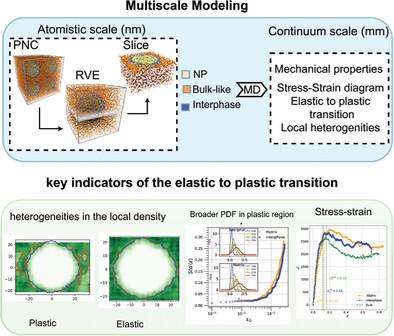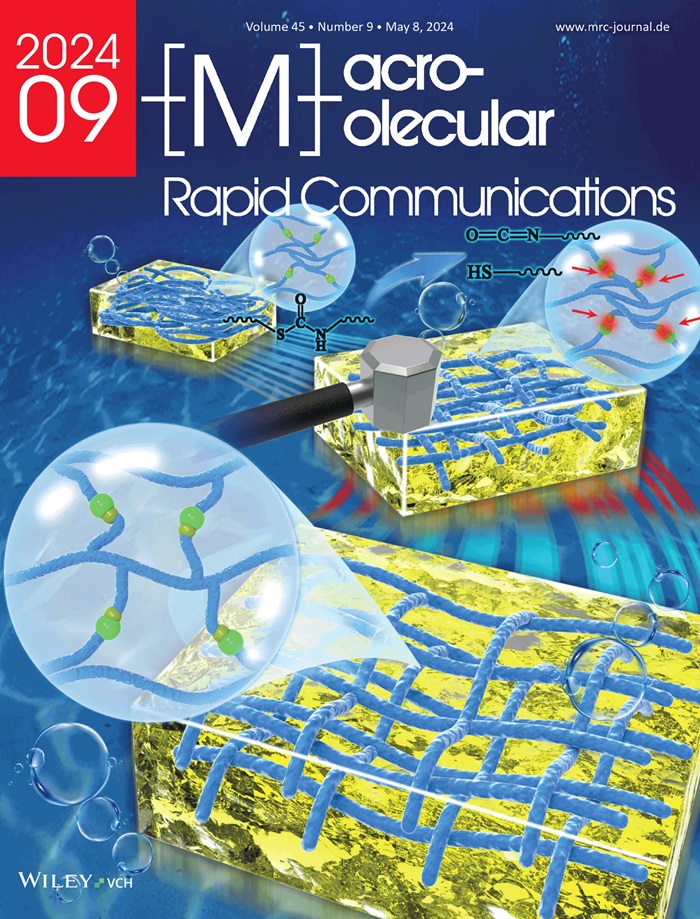Probing the Linear-to-Plastic Transition in Polymer Nanocomposites via Atomistic Simulations: The Role of Interphases
IF 4.2
3区 化学
Q2 POLYMER SCIENCE
引用次数: 0
Abstract
Polymer nanocomposites have found ubiquitous use across diverse industries, attributable to their distinctive properties and enhanced mechanical performance compared to conventional materials. Elucidating the elastic-to-plastic transition in polymer nanocomposites under diverse mechanical loads is paramount for the bespoke design of materials with desired mechanical attributes. In the current work, the elastic-to-plastic transition is probed in model systems of polyethylene oxide (PEO) and silica, SiO2, nanoparticles, through detailed atomistic molecular dynamics simulations. This comprehensive, multi-scale analysis unveils pivotal markers of the elastic-to-plastic transition, highlighting the quintessential role of microstructural and regional heterogeneities in density, strain, and stress fields, featuring the polymer-nanoparticle interphase region. At the atomic level, the behavior of polymer chains interacting with nanoparticle surfaces is traced, differentiating between free and adsorbed chains, and identifying the microscopic origins of the linear-to-plastic transition. The mechanical behavior of subregions are characterized within the PEO/SiO2 nanocomposites, focusing on the interphase and bulk-like polymer areas, probing stress heterogeneities and their decomposition into various force contributions. At the inception of plasticity, a disruption is discerned in isotropy of the polymeric density field, the emergence of low-density regions, and microscopic voids/cavities within the polymer matrix concomitant with a transition of adsorbed chains to free. The yield strain also emerges as an inflection point in the local versus global strain diagram, demarcating the elastic limit, and the plastic regime shows pronounced strain heterogeneities. The decomposition of the atomic Virial stress into bonded and non-bonded interactions indicates that the rigidity of the material is primarily governed by non-bonded interactions, significantly influenced by the volume fraction of the nanoparticle. These findings emphasize the importance of the microstructural and micromechanical environment at the polymer-nanoparticle interface on the linear-to-plastic transition, which is of great importance in the design of nanocomposite materials with advanced mechanical properties.

通过原子模拟探索聚合物纳米复合材料的线性到弹性转变:相间的作用
与传统材料相比,聚合物纳米复合材料具有独特的性能和更强的机械性能,因此在各行各业得到了广泛应用。阐明聚合物纳米复合材料在不同机械载荷下的弹塑性转变,对于定制设计具有所需机械属性的材料至关重要。在目前的研究工作中,通过详细的原子分子动力学模拟,在聚环氧乙烷(PEO)和二氧化硅(SiO2)纳米颗粒模型系统中探究了弹性到塑性的转变。这种全面、多尺度的分析揭示了弹性到塑性转变的关键标志,突出了微结构和密度、应变和应力场区域异质性的重要作用,其特点是聚合物-纳米粒子相间区域。在原子层面上,对聚合物链与纳米粒子表面相互作用的行为进行了追踪,区分了自由链和吸附链,并确定了线性到塑性转变的微观起源。对 PEO/SiO2 纳米复合材料内部各子区域的机械行为进行了表征,重点是相间和块状聚合物区域,探究应力异质性及其分解为各种力的贡献。在塑性开始时,聚合物密度场的各向同性被打破,出现了低密度区域,聚合物基体中出现了微观空洞,同时吸附链过渡到自由链。屈服应变也是局部应变与全局应变图中的一个拐点,是弹性极限的分界点,塑性体系显示出明显的应变异质性。将原子维里亚尔应力分解为成键和非成键相互作用表明,材料的刚性主要受非成键相互作用的支配,而纳米粒子的体积分数对其影响很大。这些发现强调了聚合物-纳米粒子界面的微结构和微机械环境对线性到塑性转变的重要性,这对设计具有先进机械性能的纳米复合材料具有重要意义。
本文章由计算机程序翻译,如有差异,请以英文原文为准。
求助全文
约1分钟内获得全文
求助全文
来源期刊

Macromolecular Rapid Communications
工程技术-高分子科学
CiteScore
7.70
自引率
6.50%
发文量
477
审稿时长
1.4 months
期刊介绍:
Macromolecular Rapid Communications publishes original research in polymer science, ranging from chemistry and physics of polymers to polymers in materials science and life sciences.
 求助内容:
求助内容: 应助结果提醒方式:
应助结果提醒方式:


